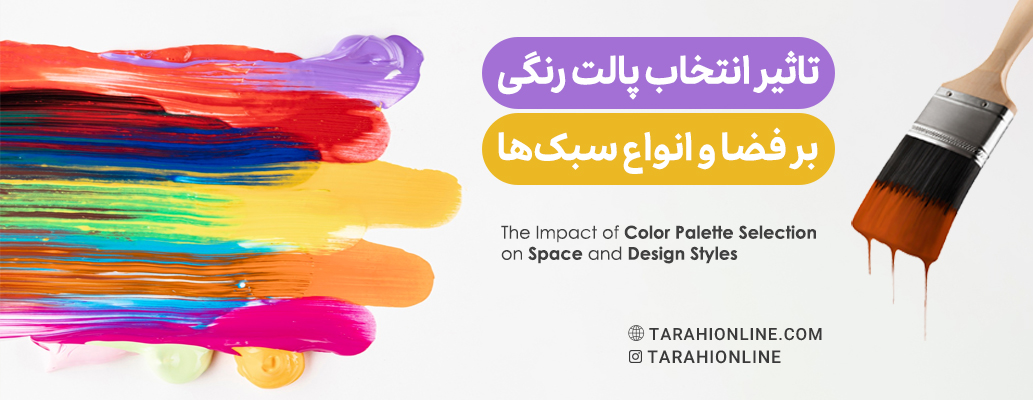
Choosing the right color palette is one of the most important factors in both interior and exterior design. Colors not only determine the aesthetic appeal of a space but also have significant psychological and emotional effects on individuals. Additionally, the choice of color palette can help define the design style and impart identity and character to a space. In this article, we will explore the impact of color palette selection on space and various design styles.
1. Psychological and Emotional Impact of Colors
Colors have a powerful ability to convey emotions and elicit psychological responses. For example, red can evoke feelings of energy and excitement, while blue creates a sense of calm and trust. Proper color selection can enhance mood and improve the overall well-being of individuals, providing a positive experience of the space.
Practical Implementation: For spaces that require energy and motivation, such as gyms or work offices, vibrant colors like red and orange can be used. For areas that need relaxation and rest, such as bedrooms or lounges, cool colors like blue and green are ideal choices.
2. Impact of Colors on Space Dimensions and Shape
Colors can also affect the perceived dimensions and shape of a space. Light and soft colors can make a space appear larger and more open, while dark and intense colors can create a sense of coziness and compactness. Using colors strategically can improve the spatial dimensions and shape, making the area more inviting.
Practical Implementation: For small and confined spaces, using light and soft colors like white, beige, and light blue can create the illusion of a larger, more open area. On the other hand, in large and open spaces, darker colors can add warmth and comfort.
3. Color Palette and Design Style
The choice of color palette plays a critical role in defining the design style of a space. Each design style has its own color palette that defines its identity and character. For example, classic styles use warm and natural colors like beige, brown, and gold, while modern styles employ cool and neutral colors like white, gray, and black.
Practical Implementation: To create a modern space, using neutral and simple colors like white, gray, and black is appropriate. Conversely, for a classic style, warm and natural colors like beige, brown, and gold are ideal choices.
4. Combining Colors and Creating Harmony
Proper color combination can help achieve harmony and balance in a space. Using complementary and contrasting colors allows designers to create beautiful and cohesive environments. Complementary colors are those that sit opposite each other on the color wheel and can create a sense of balance and harmony. Conversely, contrasting colors can introduce contrast and visual interest.
Practical Implementation: Using complementary colors like blue and orange or green and red can create balance and harmony in a space. Similarly, contrasting colors like black and white or yellow and purple can add contrast and visual appeal.
5. Impact of Colors on Perceived Warmth and Coolness
Colors can convey a sense of warmth or coolness to a space. Warm colors like red, orange, and yellow can make a space feel inviting and energetic, while cool colors like blue, green, and purple can create a sense of tranquility and calm. Proper color selection can help regulate the emotional temperature of a space and provide a pleasant experience.
Practical Implementation: For spaces that require warmth and coziness, such as living rooms or dining areas, warm colors like red, orange, and yellow are ideal. For spaces that require coolness and relaxation, such as bathrooms or bedrooms, cool colors like blue and green are the best choices.
6. Impact of Colors on Space Functionality
Colors can also influence the functionality of a space. For example, using light and soft colors in a work environment can enhance concentration and reduce stress, while dark and intense colors may increase feelings of pressure and fatigue. Appropriate color selection can improve space functionality and productivity.
Practical Implementation: In workspaces, using light and soft colors like light blue, soft green, and white can enhance focus and reduce stress. Conversely, in recreational and entertainment areas, vibrant and lively colors like red and yellow can create a sense of welcome and energy.
7. Color Palette in Small and Large Spaces
Choosing the right color palette for small and large spaces can significantly affect the overall feel of the area. In small spaces, using light and soft colors can create the illusion of a larger and more open space, while in large spaces, darker colors can add warmth and comfort.
Practical Implementation: In small spaces, use light and soft colors like white, beige, and light blue to create a sense of openness. In large spaces, darker colors like brown, gray, and dark green can provide warmth and comfort.
8. Harmonizing Color Palette with Lighting
Lighting and color palette selection should be coordinated. Colors can change under different lighting conditions, creating varying effects. Using proper lighting can enhance the effects of colors and create a pleasant ambiance.
Practical Implementation: Ensure that the lighting in the space complements the chosen color palette. For example, using warm lighting with warm colors can enhance the sense of coziness, while cool lighting with cool colors can amplify the sense of tranquility.
Selecting the appropriate color palette can have a profound impact on space and the emotions of individuals. By following the considerations mentioned in this article, you can create a beautiful and inviting environment that not only offers visual appeal but also conveys a desired mood and atmosphere. Thoughtful color selection can define design styles, improve space functionality, and create harmony and balance within the environment.